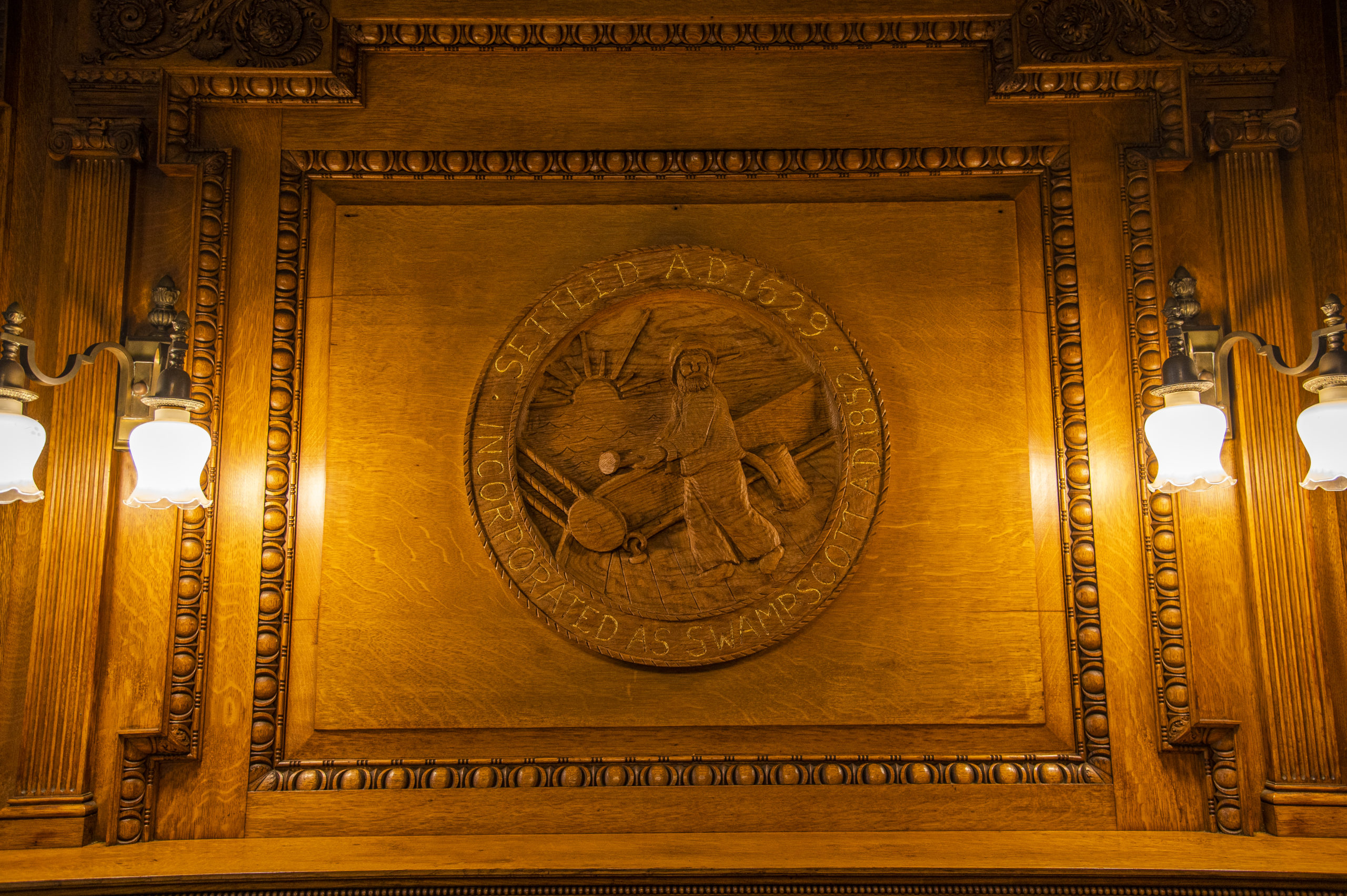What does $12 buy you? How about the original design used in the town seal seen on signs, badges, and official documents?
Already a Civil War hero and famous illustrator, Charles Wellington Reed was hired by the town in 1881 to create its seal. Town Meeting members authorized the Board of Selectmen to pay Reed $12 for his labors, the equivalent of $323 in 2021 dollars.
Reed’s design depicts Capt. James Phillips standing on the aft deck (inside the rearmost part of a boat) of a fishing schooner, holding the handle to the rudder. Phillips is wearing a sou’wester, a waterproof hat, which was created in the 1800s for fishermen of the North Atlantic. Waves crest on the oceanscape on the seal and the sun is rising in the background.
Reed was no stranger to Swampscott. A Bostonian, he made summer visits to the town. But his name continues to live on in American history not only because of the seal still in use by the town.
Reed was also a documentarian of the wartime experience. He created approximately 700 sketches that illustrated the everyday lives of ordinary northern soldiers during the war and between campaigns. Now his collection is preserved in the Library of Congress.
Reed was born in Boston on April 1, 1841 to Joseph Reed and Roxanna Richardson Reed. Some accounts say that he went to public schools and studied drawing. Others claim that he was born into a wealthy family and was educated in private schools and studied art there.
At the age of 21, Reed enlisted in the Ninth Massachusetts Light Artillery, serving much of the Civil War as a bugler. He participated in many battles including Mine Run, Gettysburg, the Wilderness, Spotsylvania, Petersburg, and Weldon Railroad.
Many letters to his family and two sketchbooks included perceptive drawings of his wartime experience. He described in detail his daily activities in letters written to his mother and sister, Helen Reed Tilton, and illustrated in drawings both the rigors of military life and the amusing aspects of it.
He documented in sketches and letters the ways in which soldiers adapted to seasonal changes in the weather, how they amused themselves, and the routines of camp life. He did a large amount of illustrations when stationed in or near Washington, D.C., in 1862, and when his unit was not actively campaigning. His illustrations are noteworthy for their intricate detail and humanity.
In 1863, during the Battle of Gettysburg, Reed saved the life of his battery’s captain, John Bigelow. Bigelow was wounded and incapacitated between enemy lines. Reed mounted his horse and led another horse under sustained fire to retrieve Bigelow, thereby saving his life, “cheered by the soldiers on both sides.”
It wasn’t until 1895 that his heroic deed was acknowledged. Bigelow wrote to the adjutant general of the U.S. recommending him for the Medal of Honor for his actions at Gettysburg. After an eyewitness testimony corroborated Bigelow’s account of events, the secretary of war approved the nomination.
In November of 1863, Reed broke his left hand, temporarily impacting his ability as someone who was left-handed to write and draw. As bad luck would have it, In August of 1864, his right hand was severely wounded by a saber slash during the Petersburg siege. Injuries aside, he worked to develop his artistic abilities, even gaining transfer to a map-making unit.
After an honorable discharge in June of 1865, Reed returned to Boston and took up art seriously. According to the Boston Globe, he became a popular illustrator, making many drawings for the paper. He illustrated a number of Civil War publications including “Hardtack & Coffee: The Unwritten Story of Army Life” (1887) by John Billings. He also did portraits, painted landscapes and marines. Reed had a studio at 12 West St. and later in the Studio Building at Tremont and Bromfield streets in downtown Boston.
Reed approached the task of designing the town seal thoughtfully, incorporating both a seascape and the history of the town into the seal.
The schooner that Phillips is standing on was called the Dove. Phillips, Jonathan Blaney and “others” purchased it in 1795 for offshore fishing. It weighed about 20 tons and was “the first little schooner owned in Swampscott,” according to the Swampscott Centennial Issue from March of 1952.
Phillips was famous for introducing to the market “Phillips Beach dunfish” which was “widely known and sought after by lovers of salted fish,” as said the booklet printed in 2002 by the Historical Commission to celebrate the 150th anniversary of the town.
Two phrases frame the round seal: “Settled in 1629” and “Incorporated as Swampscott, MA 1852.” The seal can be seen adorning several locations around town. One is incorporated onto the gable of the Fish House facing Humphrey Street. The Town Hall has two more: a carved seal on a mantle over the fireplace in the Select Board meeting room and a painted seal hanging on the wall above the staircase.
According to the Library of Congress, Reed married in 1869 to Rebecca Farwell and began operating a liquor and wine store with his father-in-law in 1871. However, according to the Boston Globe obituary, he never married and was much sought after in fraternal societies.
Reed was an honored member of Grand Army of the Republic Edward W. Kinsley Post 113, where he used to draw the menus for the annual banquet. He was also a member of the Apollo Club, the second-oldest men’s singing group in the U.S., which was a source of entertainment for well-to-do Bostonians before the radio came along.
When bicycles became popular in the 1880s, Reed became an enthusiast and a member of the old Boston Bicycle Club. He rode with the “around the hub” group annually.
When Reed died on April 29, 1926, in Norwell, where he lived in the Accord area for a few years, his obituary in the Boston Globe said that the he was “one of most famous ‘characters’ of Boston — famous as a Civil war veteran; as a Congressional Medal of Honor man; as an artist and illustrator; as a singer; as a bicyclist, and as an all-round good fellow, dearly loved by host of friends … He was bubbling over with life and energy and as ready for a frolic at 80 as he was at 30.”
He was buried at Mount Auburn Cemetery in Cambridge.
In 1928, his niece Grace M. Schirmer, born Grace May Tilton, donated to the Library of Congress his sketches, correspondence, articles, citations, military papers, clippings, a diary, maps, Medals of Honor and photographs known as The Charles Wellington Reed Papers.
The design of the Medal of Honor awarded to Civil War soldiers was first approved in 1862. The army’s Medal of Honor was redesigned in 1904 to preserve its distinctiveness as the highest honor awarded to soldiers. Charles W. Reed retained his original 1895 Medal of Honor as well as the redesigned version, both of which are part of the Charles Wellington Reed Papers at the Library of Congress.

